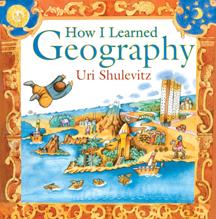Full Text Reviews: Bulletin for the Center... - 03/01/2008 In this autobiographically rooted story, our young narrator and his parents flee a war-torn country but end up in straitened circumstances in a new land: “We slept on a dirt floor. I had no toys and no books. Worst of all: food was scarce.” When the boy’s father comes home one night with a map instead of bread, the boy is hungry and furious, but after his father hangs the huge map on the wall, the youngster becomes absorbed in its infinite possibilities, traveling in his daydreams far away from his miserable current existence. A tribute to the powers of wide imaginative horizons, this gains impact from its basis in Shulevitz’ own experiences, which give it reality beyond mere wishful thinking. Ragged right text is clear and straightforward but vivid, and small memorable touches—such as the boy’s resentment at his neighbor’s loud chewing and his incantation of place names taken from the map—add dimensionality. Watercolor illustrations avoid demonizing the boy’s real life: the town (Turkestan, according to Shulevitz’ note) looks like an interesting place, but the family’s dull patched clothes speaks to their privations and contrasts them with the teeming colorfully turbaned prior inhabitants. Chunky lines and sweeps of washy watercolor gain additional textures in the map worlds, with soft intricate details in nubbly fresco-like surfaces or cities evincing a polish and regularity of pattern in their multiwindowed skyscrapers that suggests photocollage even as the changing colors recall the traditional map hues. Use this as an entrée to a discussion of maps and geography or as a resonant reminder of the power of imagination in difficult circumstances. DS - Copyright 2008 The Board of Trustees of the University of Illinois. School Library Journal - 05/01/2008 Gr 2-5-Shulevitz provides a note and early drawings to source this story based on his own childhood experience. A small boy and his parents flee Poland in 1939. They travel to Turkestan (modern-day Kazakhstan) where they live in one room in a house made of "clay, straw, and camel dung" with strangers. When the narrator's father returns from the bazaar with a huge map instead of bread to feed his starving family, his wife and son are furious. But the map turns out to provide food for his spirit as the youngster becomes fascinated by its every detail. Using his imagination, he can transport himself to all of the exotic-sounding places on it without ever leaving the dreary room in which it hangs. The folk-style illustrations, rendered in collage, watercolor, and ink, combined with the brief text, create a perfectly paced story. A page turn to discover where Father is going "one day" brings readers into a Russian bazaar with its crowds of colorful sellers and buyers, the scene closely resembling a drawing the illustrator made at age 10. Scenes framed in white depict the family boxed in by their desperate circumstances, first fleeing their war-torn country with its angry red-black sky, and then cramped in their small room in a distant land. The frames disappear as the boy imagines himself released from his confinement to travel his newly discovered world. This poignant story can spark discussion about the power of the imagination to provide comfort in times of dire need.-Marianne Saccardi, formerly at Norwalk Community College, CT Copyright 2008 Reed Business Information. - Copyright 2008 Publishers Weekly, Library Journal and/or School Library Journal used with permission. Booklist - 05/01/2008 *Starred Review* Recasting a childhood memory as a fictional tale, Caldecott Medalist Shulevitz revisits the journeying theme from his recent The Travels of Benjamin Tudela (2005), while harking back to the fanciful simplicity of Snow (1998) and So Sleepy Story (2006). Driven from home by a “war that devastated the land,“ a family flees to a remote city in the steppes. One day, the father returns from the market not with bread for supper but with a wall-filling map of the world. “‘No supper tonight,’ Mother said bitterly. ‘We’ll have the map instead.’” Although hungry, the boy finds sustenance of a different sort in the multicolored map, which provides a literal spot of brightness in the otherwise spare, earth-toned illustrations, as well as a catalyst for soaring, pretend visits to exotic lands. Shulevitz’s rhythmic, first-person narrative reads like a fable for young children. Its autobiographical dimension, however, will open up the audience to older grade-schoolers, who will be fascinated by the endnote describing Shulevitz’s life as a refugee in Turkestan after the Warsaw blitz, including his childhood sketch of the real map. Whether enjoyed as a reflection of readers’ own imaginative travels or used as a creative entrée to classroom geography units, this simple, poignant offering will transport children as surely as the map it celebrates. - Copyright 2008 Booklist. Loading...
|



